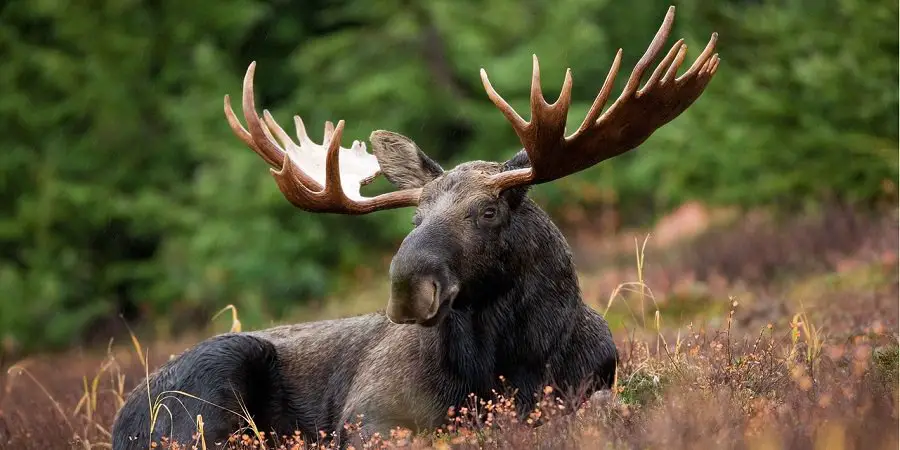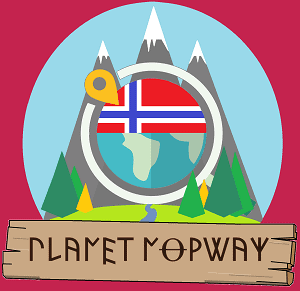Norway is Europe’s longest country stretching 1752 kilometers (1088 miles) from north to south. To put that in perspective, if you turn Norway upside down, the northern tip would reach the border between France and Spain. For US readers, it would equal the distance between Boston and Jacksonville along the east coast.
Having a relatively cold, yet temperate climate, mountainous terrain, and a long coastline make Norway’s nature varied. Also, with a population of only 5.4 million, there is plenty of nature for animals to thrive.
These factors combine to give Norway varied and relatively prosperous wildlife ranging from polar bears to dolphins. Here are 10 of the most extraordinary animals found in the Norwegian wildlife

Polar bear
Believe it or not, the polar bear is the world’s largest land-living predator on earth. Theft can reach lengths of up to 180-260 cm, a height of 170 cm, and weight anywhere between 300-600 kilos.
The polar bear is native to the northern arctic areas with lots of sea ice. Here their most important source of food is seals, which they hunt vigorously out on the vast sea ice.
In addition to its thick, white coat, the polar bear is adapted to live on the sea ice in many ways, including having papules on its paws that prevent it from sliding on the slippery ice.
While you won’t find any polar bears on mainland Norway, the territory of Svalbard is located in the territory of the Barents sea population.
While there are no exact numbers, the Barents sea population is thought to consist of less than 1000 reproductive individuals, thus the polar bear is considered an endangered species in Norway.
Muskox
The muskox is a hooved animal in the ox family, also known as the polar ox, despite being more closely related to sheep and goats than cattle.
It has short, powerful legs and a short neck. Living in cold climates, they grow thick and long brown fur. Mature individuals reach heights of about 165 cm and can weigh between 350-450 kg, however, there is a significant difference between bulls and cows, the latter being smaller.
They are specialized to live on the cold tundra in areas of relatively shallow snow cover in order to reach the vegetation underneath.
The only native populations are found in northern, arctic Canada and Greenland. The Norwegian population was introduced to the dove area after the second world war and has now become a well-established colony.
Wolverine
The Wolverine is a predator living in the arctic, subarctic tundra, and taiga throughout the northern hemisphere, including in the mountainous areas in Norway. It is an efficient hunter and one of the largest predators in Norway known to hunt both reindeer and sheep.
It has a short head with a powerful bite and a relatively long body covered in dark brown fur with a tan belt along its sides. Further back it has a short, bushy tail.
Overall, a full-grown individual can be as tall as 40-45 cm, about that of a mid-sized dog. Its weight varies with the males being bigger and heavier, but they can weigh anywhere from 8-25 kg.
Unfortunately, along with many other predators native to Norway, the Wolverine is only found in limited numbers and it is considered an endangered species in Norway.
Arctic fox
The arctic fox has made the harsh landscape in the northern hemisphere it’s home. It’s slightly smaller than its more common cousin, the red fox, measuring between 50-65 meters long and about 30 cm tall, weighing between 3-8 kg.
As a predator, its main source of food is lemmings which share their habitat. A special feature that allows the arctic fox to cursive the cold winters is its ability to change furs. During the winter, it grows a thick white coat which is shed in spring in favor of a thinner, brown, summer coat.
Due to extensive hunting in the 19th century, combined with habitat destruction, the arctic fox is now critically endangered in Norway. However, through dedicated work, one has been able to halt its decline and its numbers are slowly increasing.
Eurasian lynx
The Eurasian lynx is a mid-sized feline living in northern Europe and Asia and is the only wild feline living in Scandinavia.
It is a strong-built cap with long legs and big fur-covered paws. They are characterized by their long, black pointy tufts of hair on their ears and areas of long fur on their chin.
Their size varies according to their habitat, but a fully grown animal can be anywhere from 8-38 kg, males typically being larger. The Scandinavian population tends to be quite big and the average weight for both males and females is over 15 kg with a body length between 90-120 cm.
The lynx is an effective hunter and can prey on animals far larger than itself. Their most common prey in Norway is Roe deer. While almost extinct in the 1930s, the population is now stable, but still endangered at only 250 reproducing individuals.
Reindeer (Svalbard Reindeer)
Reindeers are a specialist within the deer family, in that it is able to live and thrive in the harsh arctic climate of the northern hemisphere. Various subspecies can be found throughout the northernmost parts of Europe, Asia (Siberia), and North America.
Reindeer change between winter and summer coats. The summer coat is grey/grown, while the winter fur is thicker, lighter, and longer. The reindeer has the most hair on every square inch among the deer family. Also, the hairs are hollow, creating an effective isolating layer. This is an important adaptation to its arctic environment.
Unlike other deer animals, both cows and bulls have horns. Also, reindeer live in herds that travel vast distances, largely dictated by the availability of food. A fully grown adult reindeer is about 1 meter tall and about 2 meters long, weighing between 80-250 kg. The bulls tend to be the largest.
Wild Reindeer are found in healthy numbers throughout the Norwegian highlands. Also, large herds of domesticated reindeer, especially by the native Sami people in northern Norway.
As mentioned, there are various subspecies of reindeer. One of them is the Svalbard REindeer. Its most distinctive feature is its shorter stature and legs compared to other species. Fully grown individuals only reach about 70% of the size and weight of wild reindeer in Mainland Norway.
Svalbard reindeer are found exclusively on Svalbard and the total population ranges between 20-25 000 individuals.
Eurasian Moose
The Eurasian moose is the world’s largest Deer-animal, and the largest land-living mammal in Norway. It is a powerfully built animal with a short neck, and a heightened shoulder area, creating a hump and long, powerful legs. Males are larger and heavier than females, and a fully-grown male can weigh up to 800 kg.
It has a very characteristic head with a long snout with large nostrils and an overreaching movable upper lip. Adult individuals, especially bulls, also grow a “beard” underneath their chin.
Another characteristic of bulls is their large horns which emerge during spring and summer before being shed during winter. While born with brown fur, it darkens with age, and fully grown bulls can look almost black.
While most commonly found in wooded areas, the moose can adapt to different habitats. In Norway, it can be found everywhere from the south-eastern lowlands to the bare mountains. Here it eats grass, herbs, leaves, and heather. The population in Norway is sizeable and stable
Atlantic puffin
The Atlantic puffin is a sea bird characterized by its large, colorful beak. This has given it the nickname sea parrot. It has a black and white body and a partly white head with a triangular-shaped eye, which gives it an almost sad look.
The Atlantic puffin nests along the north Atlantic coast from northeastern Canada to Novaja Semlja in northwestern Russia. This is not a coincidence, as large shoals of herring travel along these coasts, and herring is the main source of food for hatchlings.
The puffin only lays one egg every season which it hides among rocks or in underground tunnels that can be up to 2 meters deep. While previously found in vast numbers, their selective diet and environmental sensitivity have made them vulnerable.
Overfishing of herring and destruction of habitat has therefore led the Atlantic puffin to be considered vulnerable. This is exemplified by the southernmost colony in Bretagne, northern France which became extinct after the sinking of the oil tanker Amoco Cadiz which led to the largest oil spill in history.
White-tailed eagle
The white-tailed eagle is Norway’s largest bird of prey. They are characterized by their dark brown feather coat, plain whitetail, and yellow beak. Females are the largest and can have a wingspan of up to 2.65 meters and weigh almost 7 kilograms.
The white-tailed eagles are found dispersed throughout Europe, north and central Asia, all the way to the Pacific coast. However, its numbers have declined rapidly following the second world war.
The eagle was protected in Norway in 1968, after which the population has gradually increased from 400 mating couples to more than 3000. It can be found along the entire Norwegian coast but is more numerous further north.
Here they built nests in trees or on mountainsides along the coast where they hunt mainly fish and seabirds.
Humpback whale
The humpback whale is found in most oceans on both the northern and southern hemispheres. It has a distinctive body shape, with a knobbly head and long pectoral fins that are about ⅓ of its total body length. Its back is black, and having a small fin, while its underside is light/white.
Full Grown individuals can grow to 16-17 meters long, with the females being slightly larger, weighing up to 30-40 tons. They have quite long lifespans reaching 60-70 years.
The humpback’s main source of food is krill, but it also eats various types of fish. This includes capelin and herring which are found in Norwegian waters.
The humpback seeks out the Norwegian waters between Finnmark and Svalbard in spring. Here they feed on krill throughout the summer. Then they travel even further north, hunting for capelin before returning to the Norwegian shores in late autumn to hunt herring.
The herring can swim close to the shore, attracting the whales with them. This enables eager tourists to get a close look at these amazing, huge mammals by joining whale safaris along the northern Norwegian coast.
Closing remarks
Norway is home to a vast variety of animals, many of which could have claimed a spot on this list. However, these are some of the most typical and distinctive animals found in Norway.
If you have seen any of these amazing animals during your visit, please share your experience in the comment section below. Also if you feel free to suggest other animals that deserve a spot on this list.
